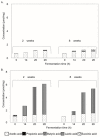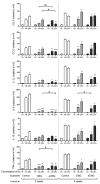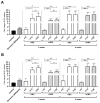Endo-1,3(4)-β-Glucanase-Treatment of Oat β-Glucan Enhances Fermentability by Infant Fecal Microbiota, Stimulates Dectin-1 Activation and Attenuates Inflammatory Responses in Immature Dendritic Cells
- PMID: 32503178
- PMCID: PMC7352905
- DOI: 10.3390/nu12061660
Endo-1,3(4)-β-Glucanase-Treatment of Oat β-Glucan Enhances Fermentability by Infant Fecal Microbiota, Stimulates Dectin-1 Activation and Attenuates Inflammatory Responses in Immature Dendritic Cells
Abstract
Background: Non-digestible carbohydrates are added to infant formula to mimic the effects of human milk oligosaccharide by acting as prebiotics and stimulating the immune system. Although not yet used in infant formulas, β-glucans are known to have beneficial health effects, and are therefore of potential interest for supplementation. Methods and results: We investigated the in vitro fermentation of native and endo-1,3(4)-β-glucanase-treated oat β-glucan using pooled fecal inocula of 2- and 8-week-old infants. While native oat β-glucan was not utilized, both inocula specifically utilized oat β-glucan oligomers containing β(1→4)-linkages formed upon enzyme treatment. The fermentation rate was highest in the fecal microbiota of 2-week-old infants, and correlated with a high lactate production. Fermentation of media supplemented with native and enzyme-treated oat β-glucans increased the relative abundance of Enterococcus and attenuated pro-inflammatory cytokine production (IL-1β, IL-6, TNFα) in immature dendritic cells. This attenuating effect was more pronounced after enzyme treatment. This attenuation might result from the enhanced ability of fermented oat β-glucan to stimulate Dectin-1 receptors. Conclusion: Our findings demonstrate that endo-1,3(4)-β-glucanase treatment enhances the fermentability of oat β-glucan and attenuates pro-inflammatory responses. Hence, this study shows that especially enzyme-treated oat β-glucans have a high potential for supplementation of infant formula.
Keywords: cytokine production; dendritic cells; in vitro fermentation; infant formula; microbiota; oat β–glucan.
Conflict of interest statement
The authors declare no conflict of interest.
Figures






Similar articles
-
Fermentation of Chicory Fructo-Oligosaccharides and Native Inulin by Infant Fecal Microbiota Attenuates Pro-Inflammatory Responses in Immature Dendritic Cells in an Infant-Age-Dependent and Fructan-Specific Way.Mol Nutr Food Res. 2020 Jul;64(13):e2000068. doi: 10.1002/mnfr.202000068. Epub 2020 Jun 2. Mol Nutr Food Res. 2020. PMID: 32420676 Free PMC article.
-
Effect of beta-glucans contained in barley- and oat-based diets and exogenous enzyme supplementation on gastrointestinal fermentation of finisher pigs and subsequent manure odor and ammonia emissions.J Anim Sci. 2010 Apr;88(4):1411-20. doi: 10.2527/jas.2009-2115. Epub 2009 Dec 18. J Anim Sci. 2010. PMID: 20023128
-
Oat bran, but not its isolated bioactive β-glucans or polyphenols, have a bifidogenic effect in an in vitro fermentation model of the gut microbiota.Br J Nutr. 2019 Mar;121(5):549-559. doi: 10.1017/S0007114518003501. Epub 2019 Jan 28. Br J Nutr. 2019. PMID: 30688188
-
Interaction between β-glucans and gut microbiota: a comprehensive review.Crit Rev Food Sci Nutr. 2024;64(22):7804-7835. doi: 10.1080/10408398.2023.2192281. Epub 2023 Mar 28. Crit Rev Food Sci Nutr. 2024. PMID: 36975759 Review.
-
Global review of heart health claims for oat beta-glucan products.Nutr Rev. 2020 Aug 1;78(Suppl 1):78-97. doi: 10.1093/nutrit/nuz069. Nutr Rev. 2020. PMID: 32728751 Review.
Cited by
-
Modulation of jejunal mucosa-associated microbiota in relation to intestinal health and nutrient digestibility in pigs by supplementation of β-glucanase to corn-soybean meal-based diets with xylanase.J Anim Sci. 2021 Jul 1;99(7):skab190. doi: 10.1093/jas/skab190. J Anim Sci. 2021. PMID: 34125212 Free PMC article.
-
An important polysaccharide from fermentum.Food Chem X. 2022 Jul 8;15:100388. doi: 10.1016/j.fochx.2022.100388. eCollection 2022 Oct 30. Food Chem X. 2022. PMID: 36211774 Free PMC article. Review.
-
Macrophage depletion alters bacterial gut microbiota partly through fungal overgrowth in feces that worsens cecal ligation and puncture sepsis mice.Sci Rep. 2022 Jun 4;12(1):9345. doi: 10.1038/s41598-022-13098-0. Sci Rep. 2022. PMID: 35661720 Free PMC article.
-
Intestinal microbiota and its interaction to intestinal health in nursery pigs.Anim Nutr. 2022 Mar;8(1):169-184. doi: 10.1016/j.aninu.2021.05.001. Epub 2021 Jun 12. Anim Nutr. 2022. PMID: 34977387 Free PMC article. Review.
-
Perspectives in the Application of High, Medium, and Low Molecular Weight Oat β-d-Glucans in Dietary Nutrition and Food Technology-A Short Overview.Foods. 2023 Mar 7;12(6):1121. doi: 10.3390/foods12061121. Foods. 2023. PMID: 36981048 Free PMC article. Review.
References
-
- WHO . Global Strategy for Infant and Young Child. Feeding. World Health Organization; Geneva, Switzerland: 2003.
MeSH terms
Substances
LinkOut - more resources
Full Text Sources
Medical

